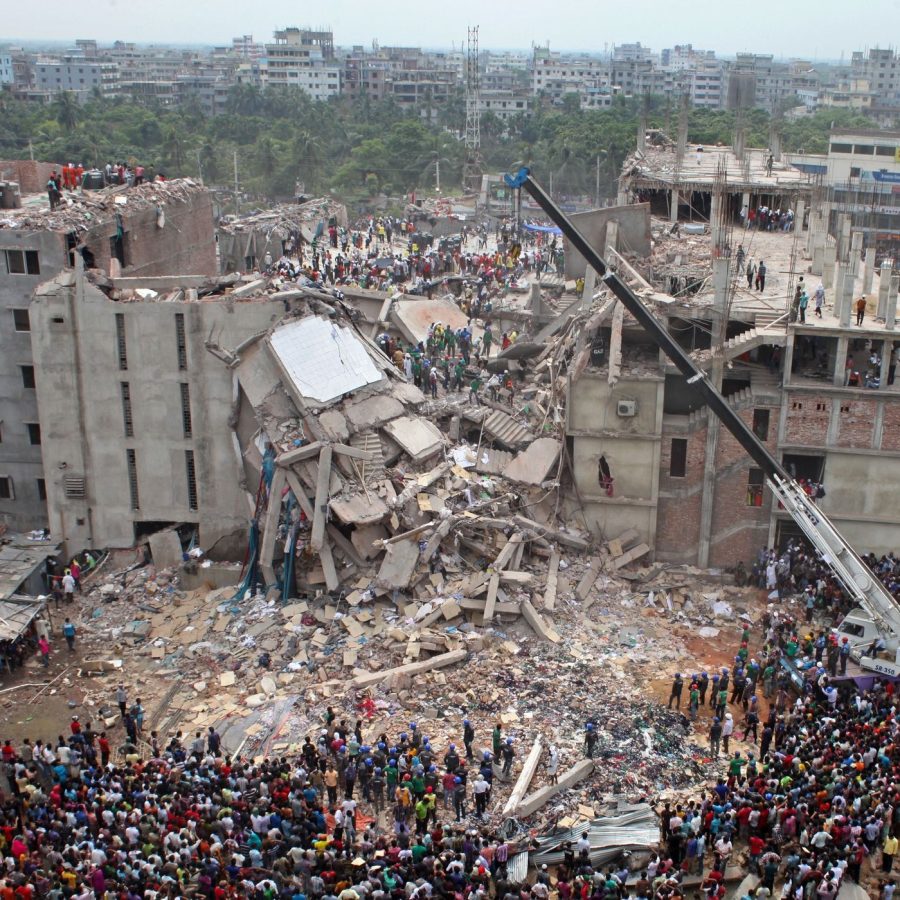The anniversary of the Rana Plaza collapse and other events that changed the public view of fast fashion
A photograph of the Rana Plaza building collapse in Dhaka, Bangladesh, on April 24, 2013.
Yesterday marked the nine-year anniversary of the collapse of the Rana Plaza in Bangladesh, which resulted in the deaths of over 1,100 workers. The underside of the fast fashion industry was exposed to the world as reports of unsafe working conditions, underage workers, and unacceptable wages were just some of the violations that were uncovered. With the huge issue of environmental sustainability aside, human rights violations still plague an industry in dire need of reform.
In May of 2015 at the Cannes Film Festival, a Kickstarter-funded documentary aired. Its title is The True Cost. Produced by Andrew Morgan, it was the first major mainstream piece shedding light on the working conditions of those employed in the supply chain that feeds fast fashion. Companies such as H&M and Inditex (Zara’s parent company) were the subjects of the film. Inditex (Zara’s parent company) is the largest retailer in the world, and H&M is the second (Wikipedia Contributors, 2019).
The release of The True Cost documentary was the next event that shed light on the human rights violations within the fast fashion industry. The making of The True Cost was motivated by the Rana Plaza collapse. “Morgan’s film follows a 23-year-old Bangladesh garment factory worker named Shima, who made the equivalent of $10 a month when first on the job. In an attempt to improve the factory’s unsafe working conditions and earn a living wage, she and several other workers started a union. When they gave the factory owner their list of demands, they were severely beaten” (Gustafson, 2015).
When The Rana Plaza tragedy happened in 2013, we, as 14-18 year olds were 5-9 respectively. While it can be debated that we had limited direct exposure to the news and information around these events, we do have exposure to the current news regarding the cotton industry and suppliers to fast fashion. The supply chain begins with raw materials such as cotton, being supplied to textile producers and garment manufacturers. In May of 2019, The Wall Street Journal broke a story about the cotton industry in Xinjiang, China. The U.S. Department of Labor confirmed the human rights violations (Against Their Will: The Situation in Xinjiang | U.S. Department of Labor, n.d.).
“The cotton harvest season in Xinjiang, China’s largest cotton-producing region… has contributed nearly 90 percent of China’s cotton production capacity and about 20 percent of the global cotton production” (Harvesting the Truth: Why Xinjiang’s Cotton Fields Offer More than Warmth, n.d.).
In response, H&M came forward in March of 2021 and said they would not use cotton produced in Xinjiang. As these reports of Xinjiang cotton workers continue to be reported on, we are being undeniably exposed to the human rights violations in the fast fashion industry. The workers are of Uyghur ethnicity and are the Muslim minority in China. They have been sent to “reeducation” camps (Connecting the Dots in Xinjiang: Forced Labor, Forced Assimilation, and Western Supply Chains, n.d.). President Biden signed a law banning any imports from the Xinjiang region this past December.
While this information is out there, little is seen on social media about it. The Fashion Revolution Movement is the largest anti-fast fashion movement in the world. Its social media campaign made #WhoMadeMyClothes and was the number one topic trending globally on Twitter in 2015. “We don’t necessarily want to be just an awareness-raising campaign,” said co-founder of Fashion Revolution, Orsola de Castro. “We are aware of the fact that we need to hit the brands and we need to hit the factory owners and we need to hit the unregulated supply chains in order to actually achieve the changes that we need to achieve” (Is Social Media Traceability’s New Superman? | Brooklyn Fashion + Design Accelerator, 2015).
The New York Fashion Sustainability and Social Accountability Act looks to expose fashion labels who are egregious in everything from environmental harms to human rights violations and financially punish them. This ground-breaking bill may be the first step in real regulations that will hold fashion labels accountable. The fast fashion cycle has been a vicious one, with the brands with the least regard for human rights reaping the biggest profits. Low wages, long work hours, unsafe working conditions, and even physical abuse are commonplace in the fast fashion industry. The Fashion Sustainability Act is a step in the right direction to break the cycle. Supply chain transparency will force labels to adhere to better practices and may slow down the chain.
Hopefully, these reports will make their way to social media platforms like Instagram and TikTok. The slowing of the supply chain will have a large impact on the success at the heart of fast fashion: being fast. This shift in the industry as well as a possible shift in buying behavior which would come from the social accountability reports via The Fashion Sustainability Act might be the convergence of the two factors to create lasting changes in fast fashion buying behavior.

Coco Corey is a senior entering her second year writing for The Central Trend. Coco plays on the tennis team, and she is also one of the four student section...


























































































